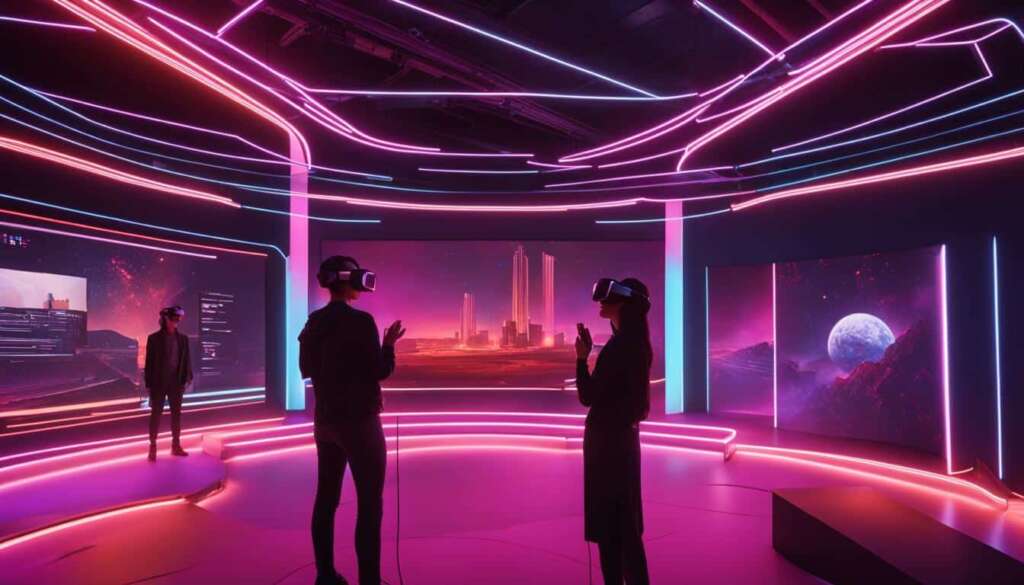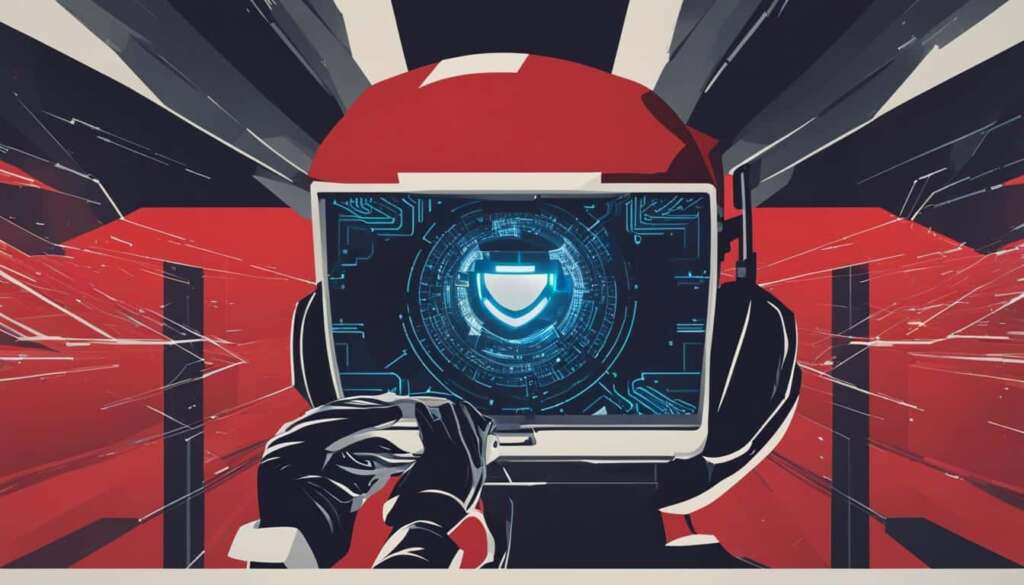Table of Contents
Virtual reality (VR) is revolutionizing the way we approach training and skill development. With immersive technologies like virtual and augmented reality, individuals can engage in active learning experiences that go beyond traditional methods of instruction. This article explores the various ways virtual reality is shaping the future of training programs.
Virtual reality training, also known as VR training or immersive training, is transforming the way we learn and develop skills. Through virtual and augmented reality simulations, individuals can engage in realistic and interactive training experiences, allowing for a more effective and engaging learning process.
Whether it’s virtual training, augmented reality training, or mixed reality training, the use of immersive technologies provides a hands-on learning environment that enhances knowledge retention and improves performance. From 3D training simulations to virtual learning platforms, virtual reality is reshaping training programs across various industries.
Stay tuned as we delve into the different applications of virtual reality training, from reducing risk in dangerous work to opening new career pathways. Discover how this technology is transforming workplace training, providing cost-effective alternatives to physical prototypes, and even improving formal education through immersive experiences.
Reducing Risk in Dangerous Work
Virtual reality (VR) training has become an essential tool in industries where dangerous tasks are involved. Companies like Interplay are providing immersive training modules that utilize VR simulations to reduce the risks associated with hazardous work. By allowing apprentices to practice tasks such as working with live wires in a virtual environment, these modules enable individuals to gain necessary experience and expertise without the risk of physical injury.
Interplay’s VR training modules not only provide a safe learning environment but also allow trainers to provide real-time guidance and assess performance. This real-time feedback helps apprentices refine their skills and improve their performance, ensuring that they are fully prepared for the challenges they may face in their line of work. The ability to practice dangerous tasks in a controlled virtual environment significantly reduces the risk of accidents and injuries, making VR training an invaluable asset in high-risk industries.
Employing VR training modules from companies like Interplay not only benefits the apprentices but also brings added advantages to employers. By reducing the risk of accidents and injuries, employers can create a safer work environment and minimize potential liabilities. Additionally, the ability to assess performance in real-time allows trainers to identify areas for improvement and provide targeted guidance, ensuring that apprentices develop the necessary skills and knowledge to excel in their roles.
Virtual reality training modules, such as those offered by Interplay, are being used in industries like electrician work to reduce the risks associated with dangerous tasks.
Table: Benefits of VR Training for Reducing Risk in Dangerous Work
| Benefits | Description |
|---|---|
| Enhanced Safety | Allows apprentices to practice dangerous tasks in a controlled virtual environment, reducing the risk of accidents and injuries. |
| Real-time Guidance | Trainers can provide immediate feedback and guidance, helping apprentices refine their skills and improve their performance. |
| Liability Reduction | By minimizing the risk of accidents and injuries, employers can create a safer work environment and reduce potential liabilities. |
The use of VR training technology, such as Interplay’s modules, is a game-changer in industries where dangerous work is involved. By offering a safe and controlled learning environment, these immersive simulations enhance safety, provide real-time guidance, and minimize potential liabilities. As VR training continues to evolve, its impact on reducing risk in dangerous work will undoubtedly become even more significant.
Increasing Caregiver Empathy and Retention
Virtual reality (VR) training platforms are transforming the way caregivers approach their work, enhancing empathy and improving retention rates. One such platform, Embodied Labs, utilizes immersive experiences to bridge the gap between caregivers and the individuals they serve. By simulating cognitive, auditory, or vision loss, caregivers can gain firsthand insight into the challenges their patients face, fostering a deeper understanding and empathy.
This innovative approach to training not only enhances the caregiver-patient relationship but also improves caregiver retention. When caregivers are equipped with the knowledge and empathy gained through VR training, they are better equipped to provide quality care and are more likely to remain in their roles long-term. This, in turn, leads to greater continuity of care and better outcomes for patients.
In addition to empathy training, VR learning platforms like Talespin offer soft skills training, including effective communication and emotional intelligence. These crucial skills are often challenging to teach through traditional methods, but VR simulations allow caregivers to practice and refine them in realistic scenarios. Studies have shown that immersive training is more effective than traditional learning methods, resulting in improved skill acquisition and application.
Enhancing Empathy Through VR Training
“Virtual reality training has transformed the way caregivers understand the experiences of those they care for. By simulating various impairments, caregivers can gain a unique perspective and develop a deeper sense of empathy.”
VR training not only benefits caregivers but also has a positive impact on patients. With improved empathy and understanding, caregivers can provide more personalized and compassionate care, ultimately enhancing the overall quality of life for those they serve.
Table: VR Training Platforms for Caregivers
| Platform | Features |
|---|---|
| Embodied Labs | – Simulates cognitive, auditory, and vision loss – Enhances empathy through firsthand experiences – Improves caregiver retention |
| Talespin | – Offers soft skills training – Focuses on effective communication and emotional intelligence – Utilizes realistic VR simulations |
By utilizing virtual reality training, the healthcare industry is elevating the standard of care provided by caregivers. These immersive experiences not only enhance empathy and understanding but also improve retention rates and overall patient outcomes. As VR technology continues to evolve and become more accessible, the potential for its impact on caregiving training is significant.
Adding Longevity to Careers
Virtual reality training is not only transforming the way we learn and develop skills but also adding longevity to careers in physically demanding trades. Platforms like Interplay have enabled experienced workers to acquire new skills and transition to less physically demanding roles within their industries. This allows them to extend their careers and maintain a steady income, while also motivating younger generations to enhance their skills through engaging training modules.
By leveraging virtual reality training, workers can acquire new skills and adapt to the changing demands of their industries. For example, a construction worker with years of experience in manual labor can use VR training to learn new skills in project management or design. This opens up opportunities for career growth and diversification, ensuring that individuals have a sustainable and fulfilling professional journey.
Through virtual reality training programs offered by Interplay, workers can easily transition into new roles without the physical strain and risk associated with their previous jobs. This not only enhances their overall job satisfaction but also provides a solution to the skill shortage problem faced by industries that heavily rely on physically demanding roles.
| Benefits of Virtual Reality Training for Career Longevity |
|---|
| 1. Extends careers of experienced workers in physically demanding trades |
| 2. Allows workers to acquire new skills and transition to less physically demanding roles within their industries |
| 3. Motivates younger generations to enhance their skills through engaging training modules |
By utilizing virtual reality training, workers can overcome physical limitations and continue contributing to their industries while maintaining their well-being. It not only benefits individual workers but also helps industries retain valuable expertise and knowledge. As technology continues to advance, virtual reality training will play an increasingly vital role in shaping the future of career development.
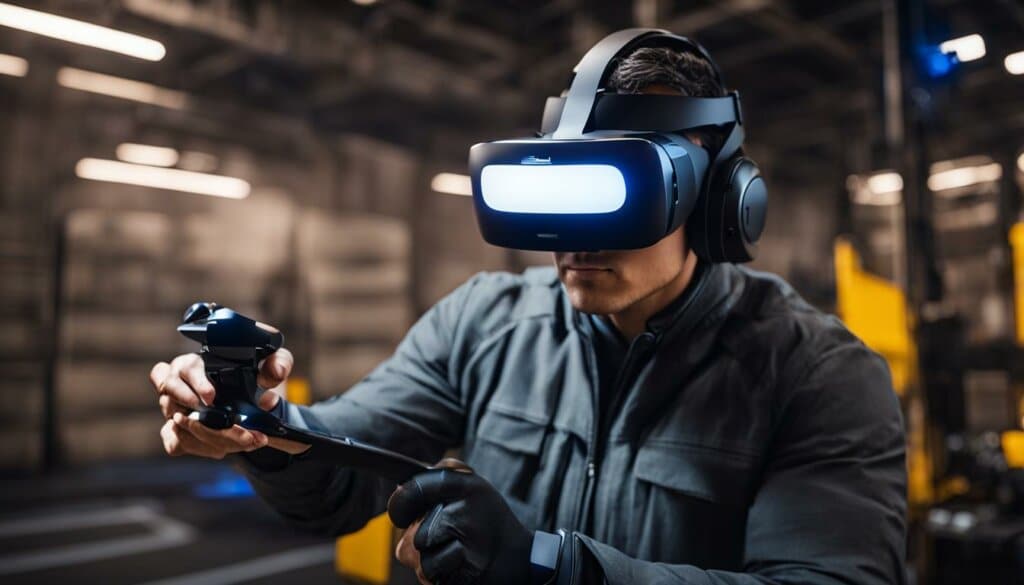
Opening New Pathways for Jobs
The adoption of immersive technologies like virtual reality has opened up new career pathways for individuals without college degrees or those seeking a career change. According to Jobs for the Future, careers in extended reality (XR) are accessible to individuals with a high school education or associate degree, or even no formal education requirements at all. This enables people who have been traditionally excluded from the technology sector to easily access and advance through immersive technologies.
One such career option in the XR field is that of an XR Technical Support Specialist. These specialists provide technical assistance and support for virtual reality (VR) and augmented reality (AR) systems and applications. They troubleshoot issues, configure hardware and software, and provide guidance and training to users. With the increasing adoption of VR and AR across industries, the demand for XR Technical Support Specialists is on the rise.
Table:
| Job Title | Education Requirements | Median Annual Salary |
|---|---|---|
| XR Technical Support Specialist | High school education or associate degree | £35,000 |
| VR Developer | Bachelor’s degree in computer science or related field | £55,000 |
| AR Designer | Bachelor’s degree in graphic design or related field | £45,000 |
| Immersive Learning Specialist | Bachelor’s degree in education or instructional design | £50,000 |
Source: Jobs for the Future
These careers offer individuals the opportunity to work with cutting-edge technologies and contribute to the development and implementation of immersive experiences. With the right training and skills, individuals can pursue rewarding careers in the XR industry, making a positive impact and shaping the future of immersive technologies.
Providing Alternatives to Physical Prototypes
Virtual reality (VR) is revolutionizing the way industries such as real estate and construction create prototypes. Companies like QUED Animations are harnessing the power of VR to design and innovate without the need for costly physical prototypes. By creating digital twins of projects, designers can collaborate in real-time and easily manipulate designs to meet new specifications, saving time and resources.
In addition to cost-effectiveness, VR prototypes offer greater flexibility and interactivity. Designers can navigate and explore virtual environments to gain a deeper understanding of the project’s spatial layout. This level of immersion allows for more accurate visualizations and enables stakeholders to make informed decisions regarding design elements and potential modifications.
“Virtual reality is transforming how prototypes are created in industries such as real estate and construction. Companies like QUED Animations utilize virtual reality to create digital twins of projects, reducing the need for costly physical prototypes.”
Furthermore, VR prototypes facilitate better communication among project teams. Stakeholders can experience and evaluate designs from various perspectives, ensuring that everyone is working towards a shared vision. This collaborative approach helps to identify and resolve potential design flaws early in the process, minimizing costly mistakes down the line.
By adopting virtual reality for prototyping, small- and medium-sized businesses particularly benefit from cost-effective and efficient design processes. With VR, they can compete with larger companies in terms of innovation while optimizing resources and reducing the risk of investing in physical prototypes that may require extensive modifications.
Table: Virtual Reality Prototyping Benefits
| Benefits | Description |
|---|---|
| Cost-Effectiveness | Eliminates the need for costly physical prototypes |
| Flexibility | Allows for real-time design modification and specification adjustments |
| Interactivity | Enables immersive exploration and evaluation of spatial layouts |
| Enhanced Communication | Facilitates collaborative decision-making and reduces design flaws |
| Competitive Advantage | Empowers small- and medium-sized businesses to innovate efficiently |
How the Future Internet Will Improve Formal Education
Virtual reality (VR) and augmented reality (AR) are set to revolutionize formal education by providing immersive experiences that enhance learning and engagement. These technologies are transforming traditional classroom settings and opening up new possibilities for students and educators alike.
Immersive Experiences and Virtual Labs
One of the key ways in which the future internet will improve formal education is through the use of immersive experiences. Virtual reality environments allow students to explore their surroundings, interact with objects, and collaborate with their peers on projects or simulations. This hands-on approach enhances student engagement and promotes active learning.
Labster, for example, offers virtual lab simulations that enable students to conduct a wide range of experiments in a safe and controlled environment. This not only improves accessibility to lab resources but also allows students to practice and refine their scientific skills without the need for physical equipment.
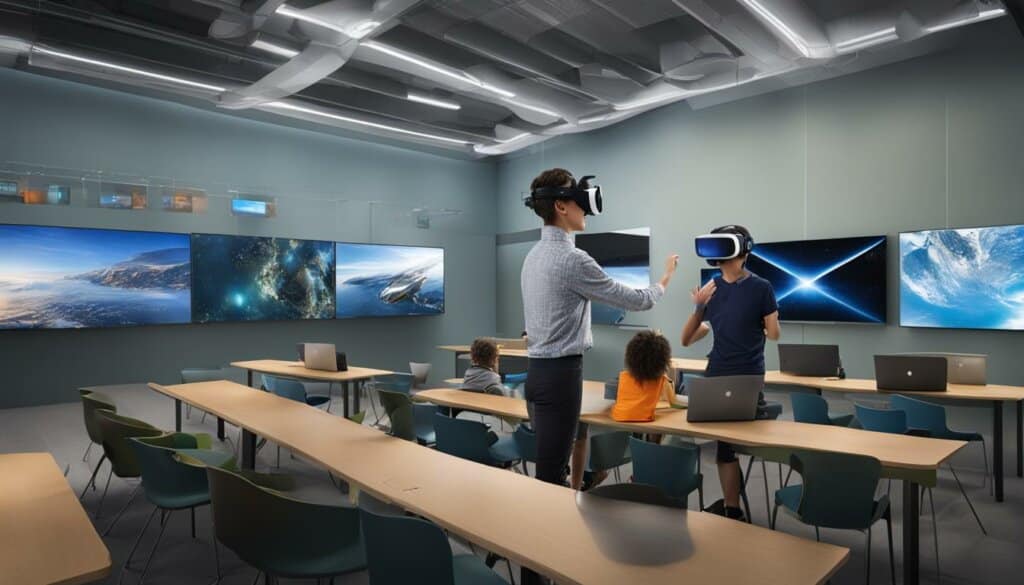
Augmented Reality Enhancements
Augmented reality is another technology that will play a significant role in improving formal education. Apps like Froggipedia utilize AR to overlay digital elements onto real-world objects, bringing concepts to life in a visually engaging way. For example, students can explore the anatomy of a frog by using their smartphones or tablets to view a virtual 3D model of the frog superimposed on their physical surroundings.
The Benefits of Immersive Learning
The integration of virtual and augmented reality into formal education offers numerous benefits. These technologies enhance student engagement, improve knowledge retention, and promote critical thinking and problem-solving skills. Students can also benefit from personalized learning experiences tailored to their individual needs and learning styles.
“Immersive technologies have the potential to transform education by providing students with experiences that go beyond traditional classroom settings,” says an expert in the field.
“By incorporating virtual and augmented reality into formal education, we can create interactive and immersive learning environments that foster creativity, collaboration, and deeper understanding.”
The Future of Formal Education
As the future internet continues to evolve, the integration of virtual and augmented reality into formal education is likely to become more widespread. These technologies have the power to transform the way students learn and educators teach, providing a more engaging and interactive educational experience.
| Benefits of Virtual and Augmented Reality in Formal Education | Implementation Challenges |
|---|---|
|
|
Despite the challenges, the potential benefits of incorporating virtual and augmented reality into formal education make it an exciting prospect for the future. As technology continues to advance, students can look forward to immersive and interactive learning experiences that will prepare them for the challenges of the digital age.
Transforming Workplace Training
Virtual reality (VR) is revolutionizing workplace training by providing realistic simulations and hands-on experiences. Companies like Igloo Vision are at the forefront of this innovative technology, enabling employees to develop essential skills and gain valuable experience in virtual environments. VR training offers numerous benefits, including enhanced information retention, improved performance, and reduced risk.
One key advantage of VR training is its ability to provide realistic simulations of dangerous scenarios. For example, oil refinery workers at BP can practice critical safety tasks in a detailed replica of the plant, allowing them to familiarize themselves with potential hazards and emergency procedures without any actual risk. By immersing employees in these virtual environments, companies can ensure that they are well-prepared to handle real-life situations.
Furthermore, VR training eliminates the need for physical locations or materials, making it both cost-effective and efficient. Instead of setting up physical training facilities or purchasing expensive equipment, companies can rely on virtual environments to deliver engaging and interactive training programs. This not only saves valuable resources but also enables organizations to reach a wider audience, regardless of geographical constraints.
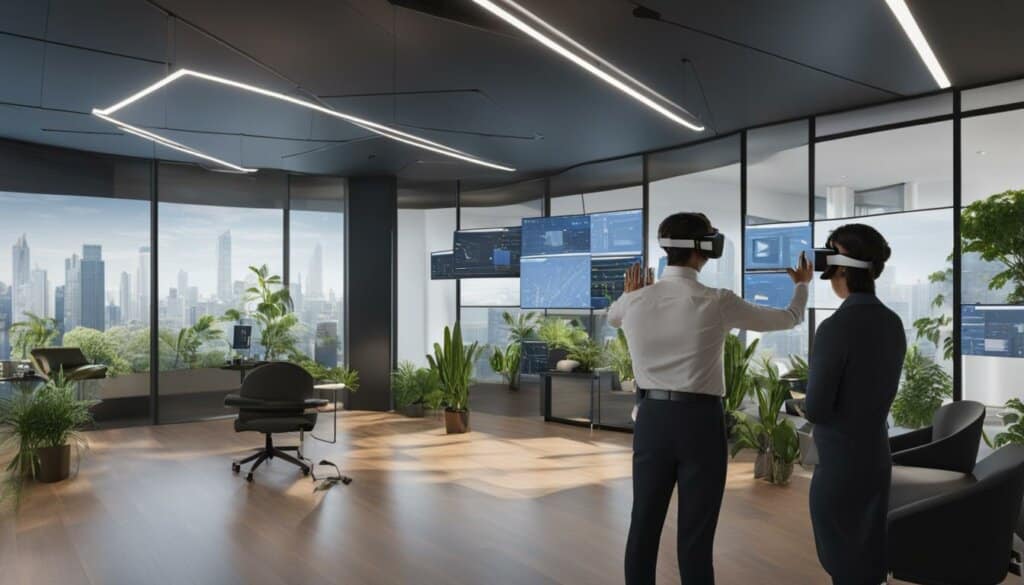
In conclusion, VR training, facilitated by companies like Igloo Vision, is transforming workplace training by offering realistic simulations, immersive experiences, and cost-effective solutions. This innovative technology provides employees with the opportunity to develop crucial skills and gain practical experience in a safe and controlled environment. As the adoption of VR training continues to grow, industries across the board will benefit from improved safety, increased efficiency, and enhanced performance.
Conclusion
Virtual reality training is transforming the way we learn and develop skills. It offers immersive and engaging experiences that enhance knowledge retention and improve performance. By simulating real-world scenarios, virtual reality is reshaping training programs across various industries, from reducing risk in dangerous work to opening new career pathways.
This technology not only improves safety and efficiency but also provides cost-effective alternatives to traditional training methods. Through virtual reality, individuals can engage in active learning experiences that go beyond traditional instruction, gaining practical skills and expertise without the risk of physical injury.
As the future internet continues to evolve, the potential for virtual reality in training and development is boundless. With advancements in virtual reality technology, we can expect even more immersive and realistic training experiences that will continue to enhance learning outcomes and shape the future of training programs.
Source: Third source
FAQ
How is virtual reality shaping the future of training programs?
Virtual reality is revolutionizing the way we approach training by providing immersive, engaging, and interactive experiences that go beyond traditional methods of instruction.
What industries are using virtual reality training modules?
Industries such as electrician work are utilizing virtual reality training modules to reduce risks associated with dangerous tasks. These modules allow apprentices to gain experience and expertise without the risk of physical injury.
How does virtual reality training improve caregiver empathy?
Virtual reality training platforms simulate cognitive and sensory impairments, allowing caregivers to gain a better understanding of the challenges their patients face. This immersive approach also improves caregiver retention.
Can experienced workers in physically demanding trades benefit from virtual reality training?
Yes, virtual reality training allows experienced workers to learn new skills and transition to less physically demanding roles within their industries, extending their careers and motivating younger generations to improve their skills.
Are virtual reality careers accessible to individuals without formal education?
Yes, careers in extended reality (XR) are accessible to individuals with high school education, associate degrees, or no formal education requirements at all, opening up new career pathways for those traditionally excluded from the technology sector.
How is virtual reality transforming prototype creation in industries like real estate and construction?
Virtual reality allows for the creation of digital twins of projects, reducing the need for costly physical prototypes. Designers can collaborate in real-time and easily manipulate designs to meet new specifications.
How is virtual reality enhancing formal education?
Virtual reality environments allow students to explore, interact, and collaborate on projects or simulations, increasing engagement and improving knowledge retention. Virtual lab simulations and augmented reality experiences bring concepts to life in a safe and engaging manner.
How is virtual reality transforming workplace training?
Virtual reality provides realistic simulations and hands-on experiences, allowing employees to develop skills and gain valuable experience without the need for physical locations or materials. This immersive learning improves information retention and reduces risks in dangerous scenarios.
How is virtual reality training reshaping the way we learn and develop skills?
Virtual reality training offers immersive and engaging experiences that enhance knowledge retention and improve performance. It is transforming training programs in various industries by improving safety, efficiency, and providing cost-effective alternatives to traditional methods.
Source Links
- https://www.forbes.com/sites/bernardmarr/2023/06/29/the-future-of-learning-reshaped-by-vr-ar-and-blockchain/?sh=26611c8f7155
- https://synergyxr.com/blogs/benefits-of-virtual-reality-in-training-and-development/
- https://about.fb.com/news/2023/05/how-the-metaverse-is-shaping-the-future-of-work/

